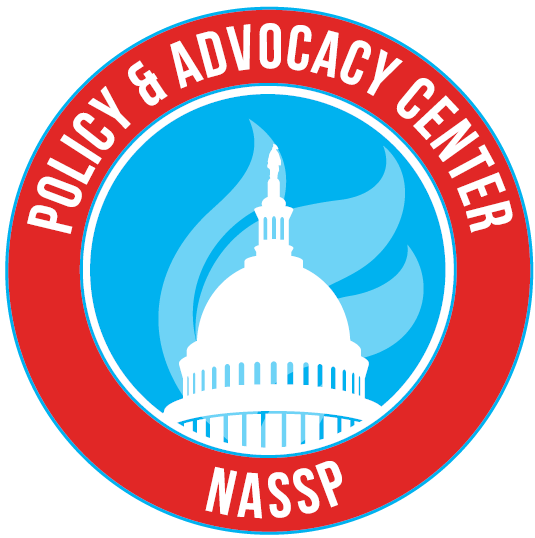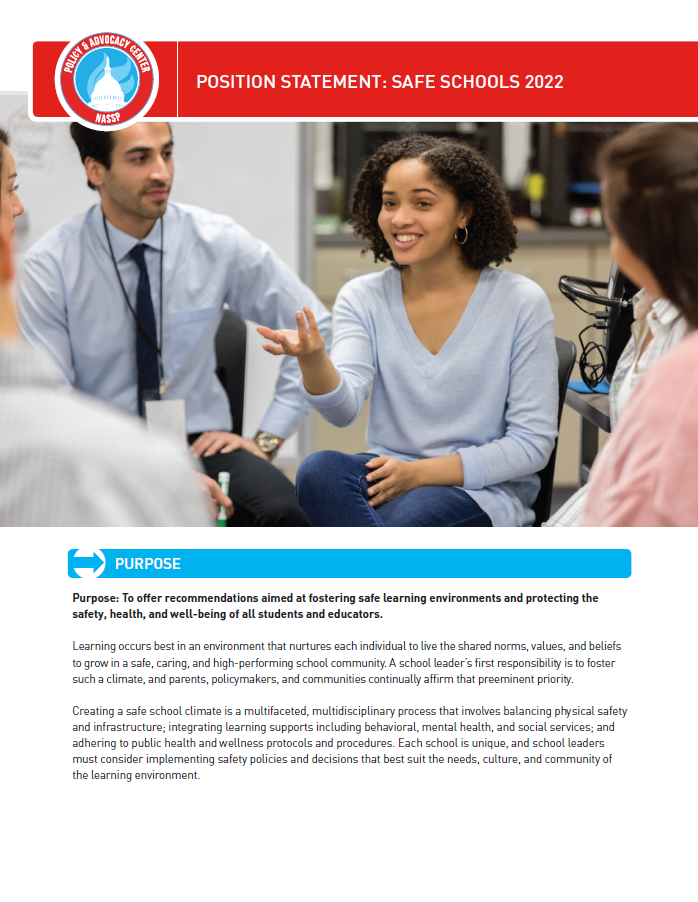Purpose: To offer recommendations aimed at fostering safe learning environments and protecting the safety, health, and well-being of all students and educators.
Learning occurs best in an environment that nurtures each individual to live the shared norms, values, and beliefs to grow in a safe, caring, and high-performing school community. A school leader’s first responsibility is to foster such a climate, and parents, policymakers, and communities continually affirm that preeminent priority.
Creating a safe school climate is a multifaceted, multidisciplinary process that involves balancing physical safety and infrastructure; integrating learning supports including behavioral, mental health, and social services; and adhering to public health and wellness protocols and procedures. Each school is unique, and school leaders must consider implementing safety policies and decisions that best suit the needs, culture, and community of the learning environment.

Still, there are universal best practices that all K–12 schools should consider and implement to create safe learning environments; provide needed mental health, social, and emotional care to students and staff; prevent violence; and reduce bullying, harassment, and other conflict, including:
- Implementing multitiered systems of support that encompass prevention, wellness promotion, and interventions that increase in focus based on student need.
- Expanding access to mental health supports by employing an adequate number of school-employed mental health professionals who are trained to infuse prevention and intervention services into the learning process and to help integrate services provided through school–community partnerships into existing school initiatives.
- Integrating positive school climate and safety efforts with crisis prevention, preparedness, response, and recovery to ensure that crisis-training and plans are relevant to the school context, reinforce learning, make maximum use of existing staff resources, facilitate effective threat assessment, and are consistently reviewed and practiced.
- Balancing physical and psychological safety to avoid overly restrictive measures, like armed guards or metal detectors, that can undermine the learning environment and instead combining reasonable physical security measures, liked locked doors and monitored public spaces, with efforts to enhance school climate, build trusting relationships, and encourage students and adults to report potential threats. If a school determines the need for armed security, properly trained and uniformed school resource officers (SROs) are the only personnel of any type who should be armed at any time in a school building.
- Employing positive and restorative school discipline practices that function in concert with efforts to address school safety and climate, are not simply punitive, are clear, consistent, and equitable, and reinforce positive behaviors. Security personnel or SROs should never be used as substitutes for effective discipline policies, as data show that does not contribute to school safety and can perpetuate the school-to-prison pipeline. Likewise, overly punitive discipline, like suspensions and expulsions, should only be utilized as an absolute last resort as those measures only contribute to opportunity and achievement gaps and make schools less safe. School discipline is the responsibility of the principal and their administrative team, and they should implement restorative practices that instill student skills to mend conflict, repair harm, and avoid violence.
Guiding Principles
- The 2015 Professional Standards for Educational Leaders state that effective educational leaders promote a school community that is inclusive, caring, supportive, and promote the academic success and well-being of each student.
- School leaders and staff members, along with community members and leaders, have a shared responsibility to ensure that schools are safe and orderly.
- Students and educators have a right to attend schools that have a safe and orderly learning environment.
- Trusting relationships in school are the most effective means of ensuring school safety.
- Building Ranks™: A Comprehensive Framework for Effective School Leaders presents a framework that defines the principal’s role for building culture and leading learning to foster lifelong success for each child in a rapidly changing world.
- NASSP has adopted separate position statements on School Discipline, School Resource Officers and Law Enforcement in Schools, Mental Health in Middle Level and High Schools, Trauma-Informed Schools, and Culturally Responsive Schools that offer further detailed policy recommendations to help schools create personalized, safe, orderly, and inviting school environments predicated on nurturing relationships and shared responsibility.
Recommendations
Federal and state policymakers should:
- Pass legislation that will allocate significant additional funding to support the recruitment, hiring, training, and employment of school-based mental health professionals until the nationally recognized recommended maximum ratios are reached: 250 students per school counselor, 500 students per school psychologist, and 250 students per school social worker.
- Invest in programs and the human capital needed to support school counseling programs, comprehensive school safety initiatives, including readiness and emergency management, mental health services, substance abuse prevention, and healthy childhood development.
- Remove barriers between education and local health service agencies and encourage local communities to focus on schools as the hub for delivery of mental and other health and social services.
- Bolster programs to prevent bullying, violence, suicide, and harassment in our nation’s schools and provide adequate wraparound mental health and behavioral services to address social-emotional development.
- Give states and local communities the ability to combine federal and state funding from separate agencies to address mental health and school safety issues at the local level.
- Do not enact policies that would allow administrators, teachers, or anyone other than specially trained SROs to carry firearms in school.
- Enact legislation to prohibit the use of corporal punishment as a form of discipline as it is ineffective in achieving positive outcomes for safety while increasing the risk for unintended negative consequences for children such as poor mental health, lower cognitive ability and academic achievement, and higher risk for physical abuse.
School and district leaders should:
- Establish school safety leadership and threat assessment teams that include key personnel: principals, teachers, school-employed mental health professionals, instruction/curriculum professionals, school resource/safety officer, and a staff member skilled in data collection and analysis.
- Assess and identify needs, strengths, and gaps in existing services and supports, like the availability of school and community resources, and unmet student mental health needs, that address the physical and psychological safety of the school community.
- Evaluate the safety of the school building and school grounds by examining the physical security features of the campus.
- Review how current resources are being applied, for example:
- Are school-employed mental health professionals providing training to teachers and support staff regarding resiliency and risk factors?
- Do mental health staff participate in grade-level team meetings and provide ideas on how to effectively meet students’ needs?
- Is there redundancy in service delivery?
- Are multiple overlapping initiatives occurring in different parts of the school or being applied to different sets of students?
- Implement an integrated approach that connects behavioral and mental health services and academic instruction.
- Provide adequate time for staff planning and problem solving via regular team meetings and ongoing professional learning communities. Identify existing and potential community partners, develop memoranda of understanding to clarify roles and responsibilities, and assign appropriate school staff to guide these partnerships, such as school-employed mental health professionals and principals.
- Provide ongoing professional development for school staff and community partners addressing school climate and safety, positive behavior, suicide prevention, and crisis prevention, preparedness, and response.
- Engage students, families, public and private social service agencies, and other agencies as partners in developing and implementing policies and practices that create and maintain a safe school environment.
- Develop responsive systems to support school safety in partnership with all stakeholders. This includes a uniform code of conduct that contains clear policies regarding discipline, bullying, and harassment and meets all federal state and board requirements pertaining to investigations, recording, and reporting.
- Use emergency preparedness plans that follow the National Incident Management System for Schools developed by the U.S. Department of Homeland Security.
- Prohibit the use of corporal punishment as a form of discipline if it is still legally permitted in the state and district as it is ineffective in achieving positive outcomes for safety while increasing the risk for unintended negative consequences for children such as poor mental health, lower cognitive ability and academic achievement, and higher risk for physical abuse.
- Ensure that non-sensorial lockdown drills are the foundation of active assailant training. Schools should not use simulation techniques with students, and exercises should be appropriate to the participants’ developmental level and physical abilities. Drills should never involve props that interject or simulate physical harm, force physical contact with participants, or include other graphic elements that could be traumatizing for participants and negatively impact the school culture.
- Regularly administer a schoolwide climate survey of students, parents, and school personnel. The climate survey should measure the degree to which collaborative leadership exists; the personalization of the school environment; and the strength of the school’s curriculum, instruction, and assessment—factors NASSP believes lead to a supportive learning environment and increased student achievement.
- Establish curricula for grades K–12 that address violence prevention, suicide prevention, and bullying, including social media aggression.
- Develop a Memorandum of Understanding (MOU) with local law enforcement that clearly defines the role of SROs to include those of law enforcement officer, teacher, and informal adviser. The MOU should make it clear that school discipline situations are the responsibility of administrators and not the SRO. School leaders should also ensure that SROs receive specialized training to work with students and in a school setting.
- Ensure that all public health guidance for schools issued by local, state, and federal health authorities is followed and administered, including recommendations for student and staff vaccinations as well as other health and safety measures.
- Partner with all stakeholders, including the news media, to ensure transparency and responsible dissemination of information regarding school safety.
Resources
- American Foundation for Suicide Prevention. (2021). Bring suicide prevention to your school. afsp.org/bringsuicide-prevention-to-your-school
- Canady, M. (2018). NASRO standards and best practices for school resource officer programs. National Association of School Resource Officers. nasro.org/clientuploads/AboutMission/NASRO-Standards-and-Best-Practices.pdf
- Centers for Disease Control and Prevention. (2019). Youth risk behavior surveillance—United States, 2019. MMWR Supplement, 69(1). cdc.gov/healthyyouth/data/yrbs/pdf/2019/su6901-H.pdf
- Cowan, K. C., Vaillancourt, K., Rossen, E., & Pollitt, K. (2013). A framework for safe and successful schools. National Association of School Psychologists. nasponline.org/resources-and-publications/resources-and-podcasts/school-climate-safety-and-crisis/systems-level-prevention/a-framework-for-safe-andsuccessful-schools
- Cybersecurity & Infrastructure Security Agency. (2018). K–12 school security: A guide for preventing and protecting against gun violence. cisa.gov/publication/k-12-school-security-guide
- National Association of School Psychologists. (2021). Best practice considerations for armed assailant drills in schools. nasponline.org/resources-and-publications/resources-and-podcasts/school-climate-safetyand-crisis/systems-level-prevention/best-practice-considerations-for-armed-assailant-drills-in-schools
- National Threat Assessment Center, U.S. Secret Service. (2018). Enhancing school safety using a threat assessment model: An operational guide for preventing targeted school violence. secretservice.gov/sites/default/files/reports/2020-10/USSS_NTAC_Enhancing_School_Safety_Guide.pdf
- National Threat Assessment Center, U.S. Secret Service. (2021). Averting targeted school violence: A U.S. Secret Service analysis of plots against schools. secretservice.gov/sites/default/files/reports/2021-03/USSS%20Averting%20Targeted%20School%20Violence.2021.03.pdf
- Rossen, E., & Cowan, K. C. (2012). A framework for school-wide bullying prevention and safety. National Association of School Psychologists. nasponline.org/resources-and-publications/resources-and-podcasts/school-climate-safety-and-crisis/school-violence-resources/bullying-prevention
- Safe and Sound Schools. (2021). 2021 state of school safety report. safeandsoundschools.org/wp-content/uploads/2021/07/School.Safety.Study_.2021.FINAL_.pdf
- U.S. Department of Homeland Security (DHS), U.S. Department of Education (ED), U.S. Department of Justice (DOJ), & U.S. Department of Health and Human Services (HHS). (2021). Federal school safety clearinghouse. schoolsafety.gov/

